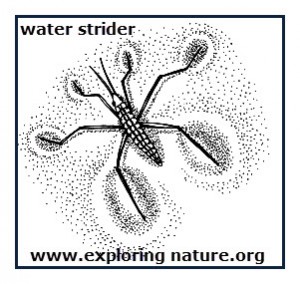What Characteristics Identify Water Striders as Insects?
Insects have many different shapes, sizes, and weights. Some, like the water strider in the video, can stand and move across the water from 3 to nearly 5 feet per second. The video is in slow motion.
Like all insects, water striders have three pairs of legs and three body parts (head, thorax, abdomen). This is refered to as the 3+3 rule for identifying insects–3 pairs of legs, 3 body parts.
Another characteristic of insects that is true for water striders is that their legs are attached to the center center body part, the thorax.
The water strider’s front and back legs act much like rudders (steering devices).
The water strider’s center pair of legs do all the paddling. The movement of this pair of legs is basically sculling, meaning they row, shooting the water back, but they never break the surface of the water.
This website: Exploring Nature: Water Strider has more information about Water Striders. This water strider diagram is used, courtesy of Exploring Nature.
The water spider is able to stand and move across the surface of water because of water’s surface tension. Here is where you will find an explanation of surface tension and an exploratory investigation about Surface Tension.
Scientists are always searching for answers, and the water strider has presented many questions. Information about this insect has been helpful in the development of robots that can move across the water’s surface.
